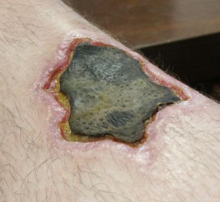| Loxoscelism | |
|---|---|
 | |
| Specialty | Emergency medicine |
Loxoscelism (/lɒkˈsɒsɪlɪzəm/) is a condition occasionally produced by the bite of the recluse spiders (genus Loxosceles). The area becomes dusky and a shallow open sore forms as the skin around the bite dies (necrosis). It is the only proven type of necrotic arachnidism in humans.[1][a] While there is no known therapy effective for loxoscelism, there has been research on antibiotics, surgical timing, hyperbaric oxygen, potential antivenoms and vaccines.[1] Because of the number of diseases that may mimic loxoscelism, it is frequently misdiagnosed by physicians.[b]
Loxoscelism was first described in the United States in 1879 in Tennessee.[2] Although there are up to 13 different Loxosceles species in North America (11 native and two nonnative), Loxosceles reclusa is the species most often involved in serious envenomation. L. reclusa has a limited habitat that includes the Southeast United States. In South America, L. laeta, L. intermedia (found in Brazil and Argentina), and L. gaucho (Brazil) are the three species most often reported to cause necrotic bites.
- ^ a b c d Swanson, David L.; Vetter, Richard S. (2006). "Loxoscelism" (PDF). Clinics in Dermatology. 24 (3): 213–21. doi:10.1016/j.clindermatol.2005.11.006. PMID 16714202. Archived from the original (PDF) on 30 June 2019. Retrieved 12 April 2011.
- ^ Appel, MH; Bertoni da Silveira, R; Gremksi, W; Veiga, SS (2005). "Insights into brown spider and loxoscelism" (PDF). Invertebrate Survival Journal. 2 (2). University of Modena and Reggio Emilia: 152–158. ISSN 1824-307X. Archived from the original (PDF) on 22 July 2011. Retrieved 12 April 2011.
Cite error: There are <ref group=lower-alpha> tags or {{efn}} templates on this page, but the references will not show without a {{reflist|group=lower-alpha}} template or {{notelist}} template (see the help page).